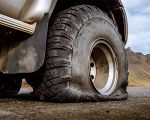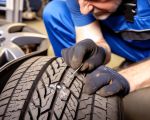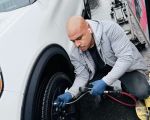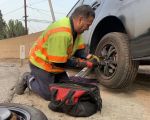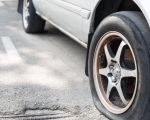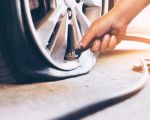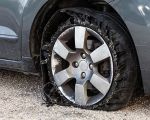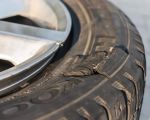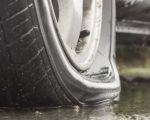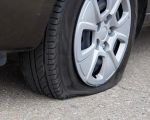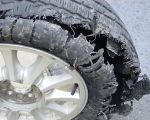How Can Low Tire Pressure Lead to a Blowout? Understanding the Risks and Preventive Measures
One of the most common and often overlooked issues that drivers face is low tire pressure. I’ll admit, there was a time when I didn’t think much about it. I'd drive along, not even noticing the subtle drop in pressure, until one day, everything changed. A flat tire quickly turned into a terrifying blowout, and I realized just how important it is to maintain the right tire pressure. In this article, I’ll explain how low tire pressure can lead to a blowout, share personal experiences, and offer tips on how to avoid such a dangerous situation.

MR. TIRE INC.
2078 New York Ave, Huntington Station, NY 11746, USA
1. What Exactly Happens When Tire Pressure Is Too Low?
It’s easy to dismiss the tire pressure warning light on your dashboard, thinking it’s just another minor issue. But here’s the thing: low tire pressure isn’t something that should be ignored. When a tire is under-inflated, it doesn’t have the same ability to support the weight of the vehicle. This affects how the tire makes contact with the road, creating more friction and causing the tire to heat up faster. Over time, the constant heat buildup can weaken the tire’s structure, increasing the likelihood of a blowout.

MR. TIRE INC.
2078 New York Ave, Huntington Station, NY 11746, USA
1.1 How Low Pressure Affects the Tire
When a tire is under-inflated, the surface area in contact with the road increases because the tire is flattened more than it should be. This leads to more friction, and friction generates heat. If the tire isn’t inflated properly, it can’t shed that heat effectively. This heat builds up inside the tire, making the rubber more vulnerable. Over time, the tire becomes more brittle and less capable of handling the stresses of the road.
Think of it like a piece of rubber that’s slowly being stretched too much. Eventually, it can’t take the pressure anymore, and it bursts—this is the moment a blowout happens. Low tire pressure also means less air inside the tire, which increases the risk of sharp objects like nails puncturing it. This can lead to a sudden, dangerous blowout if the tire cannot seal the puncture effectively.
1.2 Pressure Loss Over Time
Tires naturally lose a small amount of pressure over time, but extreme temperature changes or under-inflation can cause a more significant drop. For example, if you're driving in hot weather, the heat can increase the pressure in your tires temporarily, but once you stop or the temperature drops, the pressure can fall rapidly. This is especially risky during colder months when tire pressure drops as the temperature falls. A quick check of tire pressure can help you avoid these dangers and ensure that your tires are always in optimal condition.
2. Real-Life Experience: The Day My Tire Burst
Let me take you back to a particularly nerve-wracking day I’ll never forget. I was driving to a weekend getaway, cruising down the highway with my family in tow, when I suddenly felt a vibration that was a little stronger than usual. At first, I dismissed it. The road wasn’t perfect, but it wasn’t terrible either. However, within a few minutes, I felt the car pulling to one side, and that’s when I knew something was wrong. I pulled over, and sure enough, my rear tire had completely blown out.
It was only after the incident that I realized the cause. My tire pressure had been low for a while, but I hadn’t thought much of it. The vibration I felt was the early stages of pressure loss, and once the tire couldn’t handle the additional heat and friction, it exploded. Thankfully, I was able to pull over safely, but the experience was terrifying. The tire itself was completely destroyed, and I had to wait for a tow truck to take me to the nearest service center for a replacement. That’s when I made a vow to never ignore my tire pressure again.
2.1 What Went Wrong
Looking back, I could have avoided the blowout if I had taken simple precautions. One of the main problems was not checking my tire pressure regularly. Low tire pressure wasn’t something I considered a priority until that incident. I had been driving on the under-inflated tire for too long, and eventually, it gave way to the stress of the road, leading to a sudden and dangerous blowout.
2.2 The Importance of Regular Tire Checks
Since that experience, I’ve made it a point to regularly check my tire pressure, especially before long trips. A simple tire pressure gauge is a small investment that can prevent a blowout and save you from being stranded. Most vehicles come with a built-in warning system, but relying solely on that can be risky. I learned the hard way that taking a minute to manually check tire pressure could have saved me from a stressful and costly situation.
3. The Dangers of a Blowout
A tire blowout can happen at the worst possible moment. Imagine driving at high speeds on the freeway when suddenly, your tire bursts. The sudden loss of pressure can cause the vehicle to lose control, increasing the risk of a severe accident. Blowouts at high speeds are particularly dangerous because they can result in the vehicle swerving uncontrollably, making it difficult to steer and brake properly.
3.1 How Blowouts Affect Vehicle Control
When a tire blows out, the sudden loss of air causes the vehicle to pull in the direction of the deflated tire. This can cause the driver to lose control, especially if they are traveling at high speeds. The vehicle’s stability is compromised, and it’s incredibly difficult to steer or maintain the vehicle’s lane. It’s a situation I wouldn’t wish on anyone, which is why understanding how tire pressure plays a role in preventing blowouts is crucial.
3.2 Risks of Rear and Front Tire Blowouts
The risks of blowouts are different depending on which tire bursts. A blowout on the rear tire can cause the car to swerve and fishtail, whereas a blowout on the front tire can affect steering directly, causing you to lose control entirely. Both situations are dangerous, but rear tire blowouts are often considered less catastrophic than front tire blowouts because the driver still has some ability to steer the vehicle with the front tires intact. Still, neither is ideal, and both situations can lead to accidents if not handled quickly and safely.
4. How to Prevent Low Tire Pressure from Leading to a Blowout
It’s clear that low tire pressure can be the cause of a dangerous blowout, but the good news is that it’s easy to prevent. Keeping your tires properly inflated is the best way to reduce the risk of blowouts. Here’s how you can make sure your tires are in tip-top shape:
4.1 Check Tire Pressure Regularly
Make it a habit to check your tire pressure at least once a month, especially before long trips. You can do this with a simple tire pressure gauge, which is widely available at most auto stores. The correct tire pressure for your vehicle can usually be found in the owner's manual or on the sticker inside the driver’s side door. If you’re unsure, most service stations offer free air pumps that can help you top off your tires to the correct pressure.
4.2 Keep an Eye on Tire Wear
In addition to checking tire pressure, it’s important to inspect the tread of your tires. Worn-out tires are more prone to blowouts, especially when they’re under-inflated. If you notice the tread is getting low, it’s time to replace the tire. Regular rotations and balancing also help ensure that your tires wear evenly and last longer, reducing the risk of blowouts.
4.3 Replace Worn or Damaged Tires
If you notice that your tires are damaged, have cuts, or are too old, it’s time to replace them. Tires don’t last forever, and older tires are more susceptible to issues like blowouts. Having them replaced before they get to that point is crucial for your safety on the road. I’ve made it a point to replace my tires at the first sign of wear, and it has given me peace of mind on long drives.
By regularly checking tire pressure, maintaining proper inflation, and inspecting for damage, you can significantly reduce the risk of a blowout caused by low tire pressure. These simple steps not only improve your safety on the road but also help save money in the long run by extending the life of your tires.














